10+ Blog Examples
Blogs have transformed the way we share information and express our thoughts online. A blog, short for “weblog,” is a digital platform where individuals, groups, or businesses can publish articles, insights, and updates. Whether you’re looking to dive deep into a hobby, stay updated on industry trends, or share personal stories, starting a blog can be a rewarding way to connect with like-minded individuals and build an online presence.
What is a Blog?
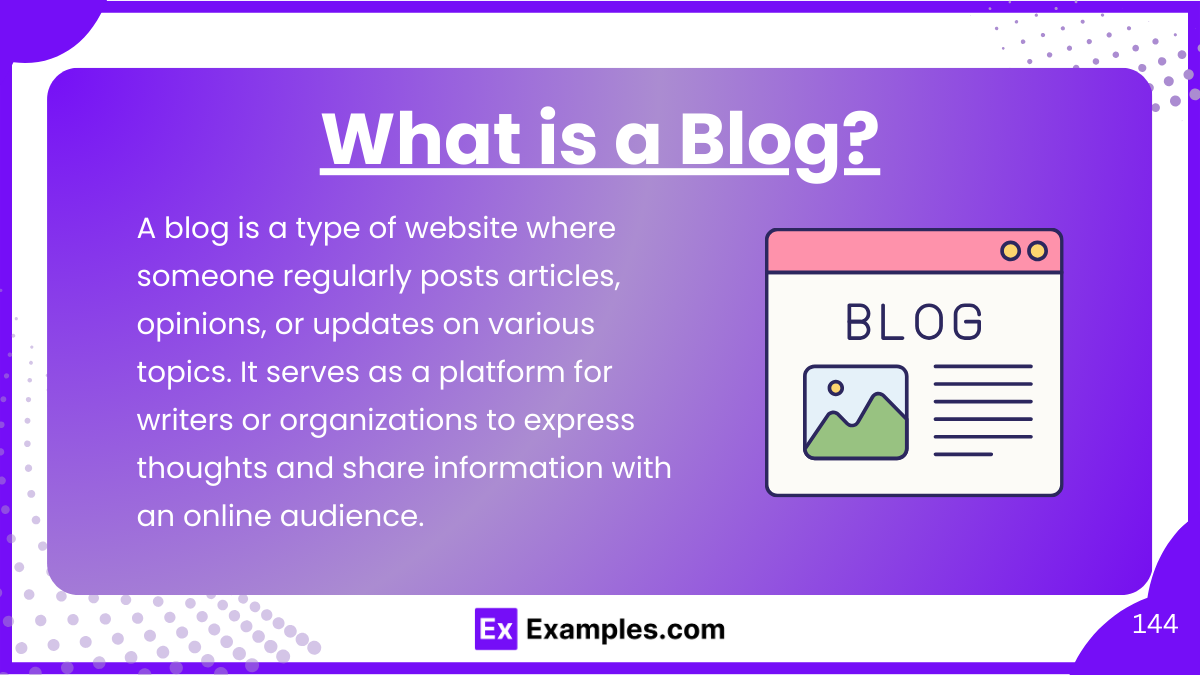
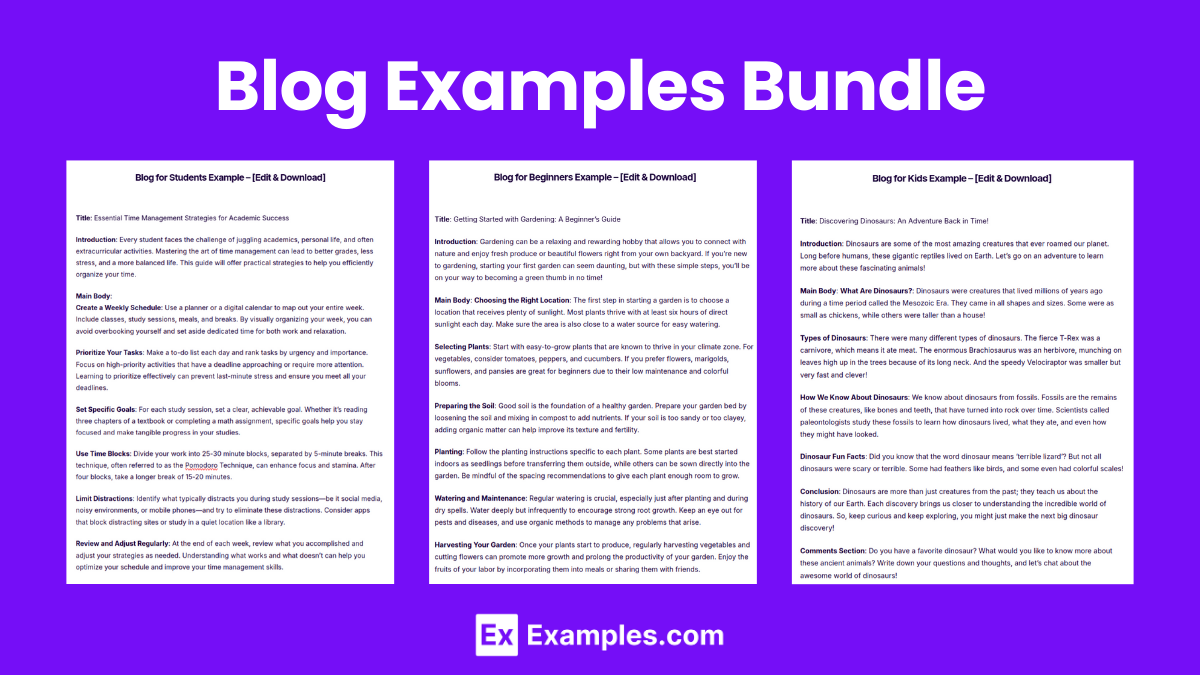
Blog Format
Title
The headline of the post that catches attention and clearly indicates what the article is about.
Introduction
A brief section that introduces the topic, catches the reader’s interest, and explains what the post will cover.
Main Body
The core part of the post where the main information is detailed. This section is often broken into subsections with their own headings to organize the content effectively.
Conclusion
A summary that wraps up the article, often with a call to action or a concluding thought to leave the reader with something to ponder or do.
Comments Section
An area at the end of the post where readers can leave their comments and engage with the content.
Blog Example
How to Start a Garden in Your Backyard
Starting a garden in your backyard can be a fulfilling and fun project. Whether you have a tiny patch or a large plot, this guide will help you get started. First, choose the right spot—most vegetables and flowers require about 6 to 8 hours of sunlight daily. Test your soil to understand what nutrients it might lack and what you can add to help your plants thrive.
Begin by selecting easy-to-grow plants that are appropriate for your climate. Herbs like basil and cilantro, vegetables like tomatoes and cucumbers, and flowers like sunflowers and marigolds are great for beginners. Use high-quality seeds or seedlings from a trusted nursery to ensure good growth.
Prepare your garden beds by loosening the soil and adding organic matter like compost. This improves drainage and provides nutrients to your plants. Plant your seeds or seedlings following the instructions on their packets. Be sure to water them gently but thoroughly to establish roots.
As your garden grows, keep it weeded and check for pests regularly. A little maintenance can prevent many problems. Don’t forget to enjoy the process and the progress. Soon, you’ll be able to enjoy the fruits (and vegetables!) of your labor right from your own backyard.
Remember, gardening is a journey, not a race. Take your time, learn as you go, and don’t be afraid to get a little dirty. Happy gardening!
Blog Examples
Blog for Students

Blog for Beginners
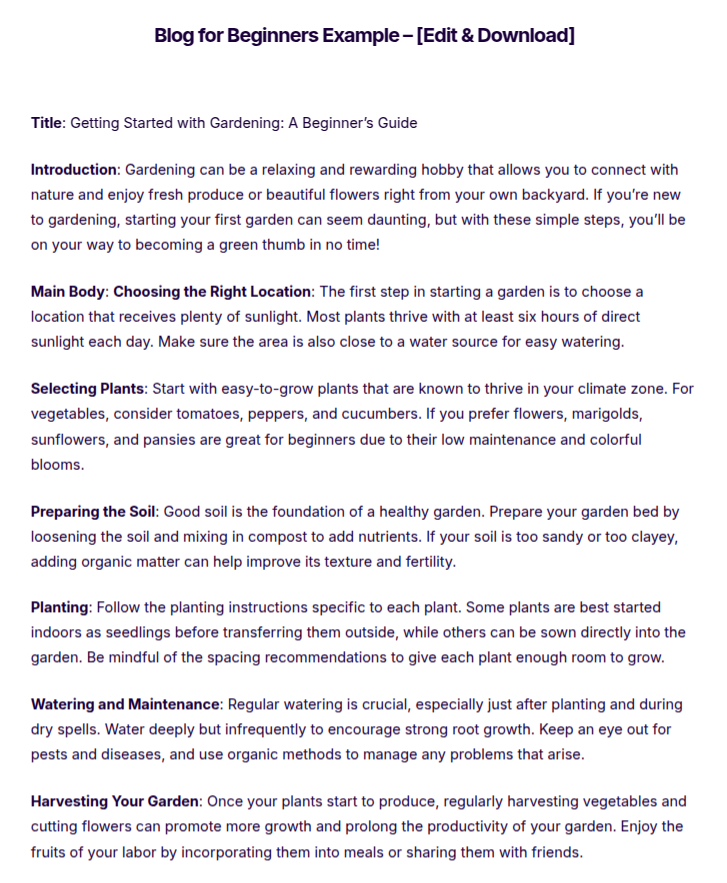
Blog for Kids

More Examples on Blog
- Blog for Website
- Blog for Food
- Blog in Literature
- Blog for School
- Travel Blog
- Article Blog
- Personal Blog
Example Blog Entry

Sample Blog Post
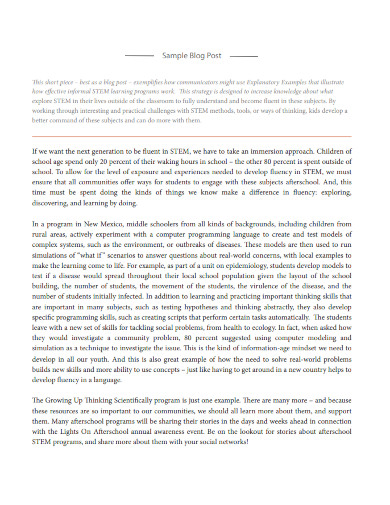
Writing Academic Blog Template
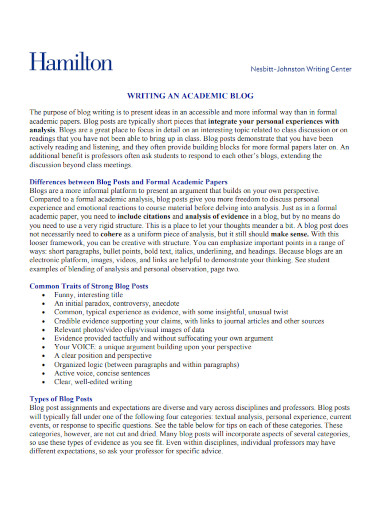
Blog Exemplar WebQuest

Sample Blog Privacy Policy Template
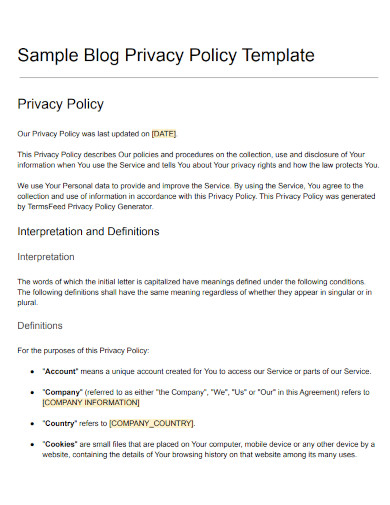
Sample Blog Permission Form
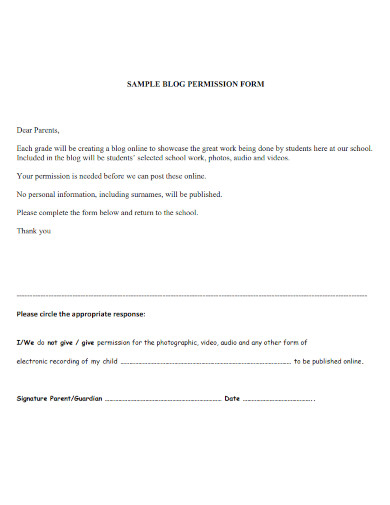
A Blog Mining Framework
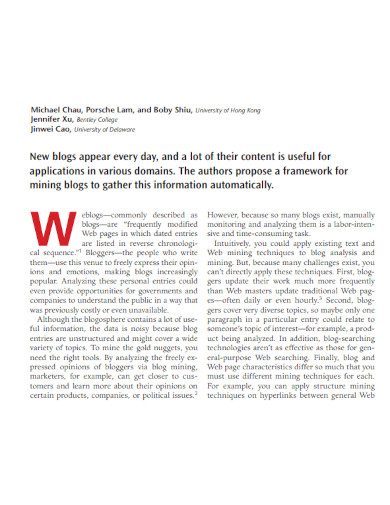
Sample Blog Post with Comments

Blog Post Sample
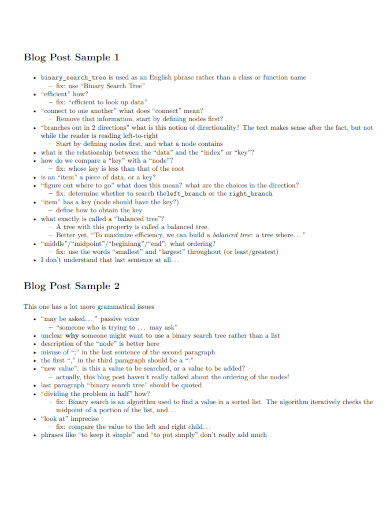
Critique of a Blog Entry Sample
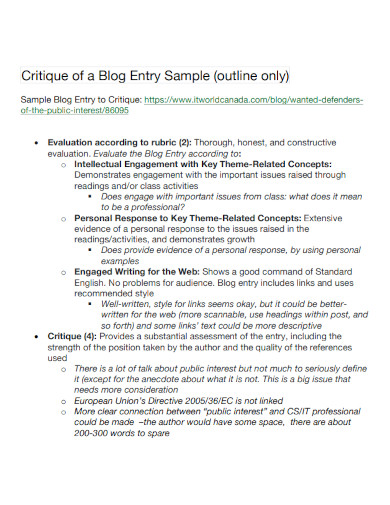
Sample Online Blog Response
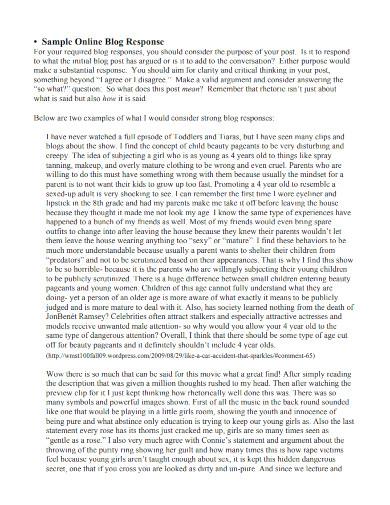
Types of Blog
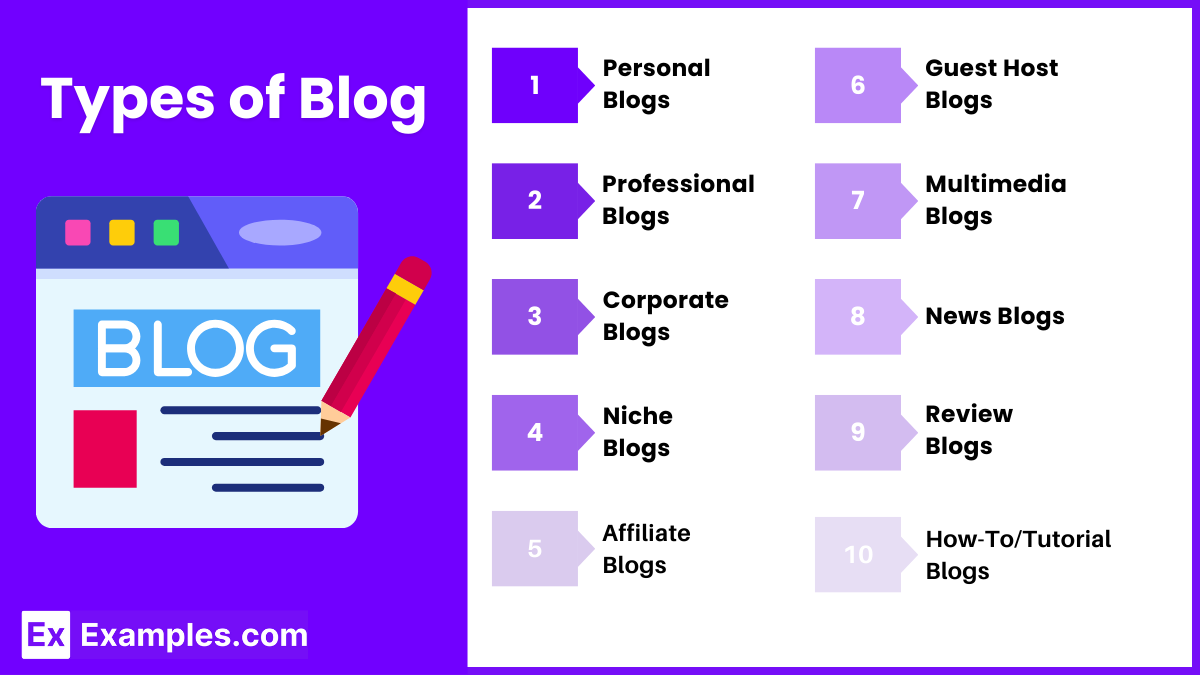
Blogs come in many forms and cater to a wide range of interests and purposes. Here are some of the main types of blogs you can find:
1. Personal Blogs
These are the original form of blogging, often resembling an online diary. Personal bloggers share their experiences, thoughts, and everyday activities, allowing for a personal connection with their readers.
2. Professional Blogs
Run by individuals or small groups to showcase expertise in a professional field, these blogs often focus on industry insights, career tips, and educational content to enhance professional credibility and authority.
3. Corporate Blogs
Used by companies to communicate with customers and clients, corporate blogs share updates, industry news, and professional insights. They’re a key element in content marketing strategies, aiming to attract and engage customers.
4. Niche Blogs
These focus on specific topics, such as personal finance, health and wellness, technology, or hobbies like photography or gardening. Niche bloggers typically aim to go deep into their subject matter to attract a dedicated following.
5. Affiliate Blogs
Affiliate marketing blogs are designed to generate revenue by promoting third-party products or services. Bloggers include affiliate links in their posts and earn commissions on the sales or leads they generate.
6. Guest Host Blogs
In these blogs, the original blogger invites other writers to contribute posts. This approach can offer a variety of viewpoints and expertise, and is a way to keep content fresh and diverse.
7. Multimedia Blogs
These include vlogs (video blogs) and podcasts (a blogs), where content is primarily in video or a format. Such blogs appeal to audiences who prefer these mediums over reading.
8. News Blogs
Focusing on news and current events, these blogs can either cover all types of news or be specific to an industry or topic, like technology or entertainment. They often provide quicker, more personalized reports than traditional news outlets.
9. Review Blogs
Review blogs provide evaluations of products, services, or experiences and can influence consumer decisions. These bloggers often gain a reputation for their expertise and fairness in reviewing.
10. How-To/Tutorial Blogs
These are instructional blogs that teach readers how to perform specific tasks or projects. They can cover a broad range of topics, from simple life hacks and recipes to complex DIY projects and technical tutorials.
How to Write a Blog
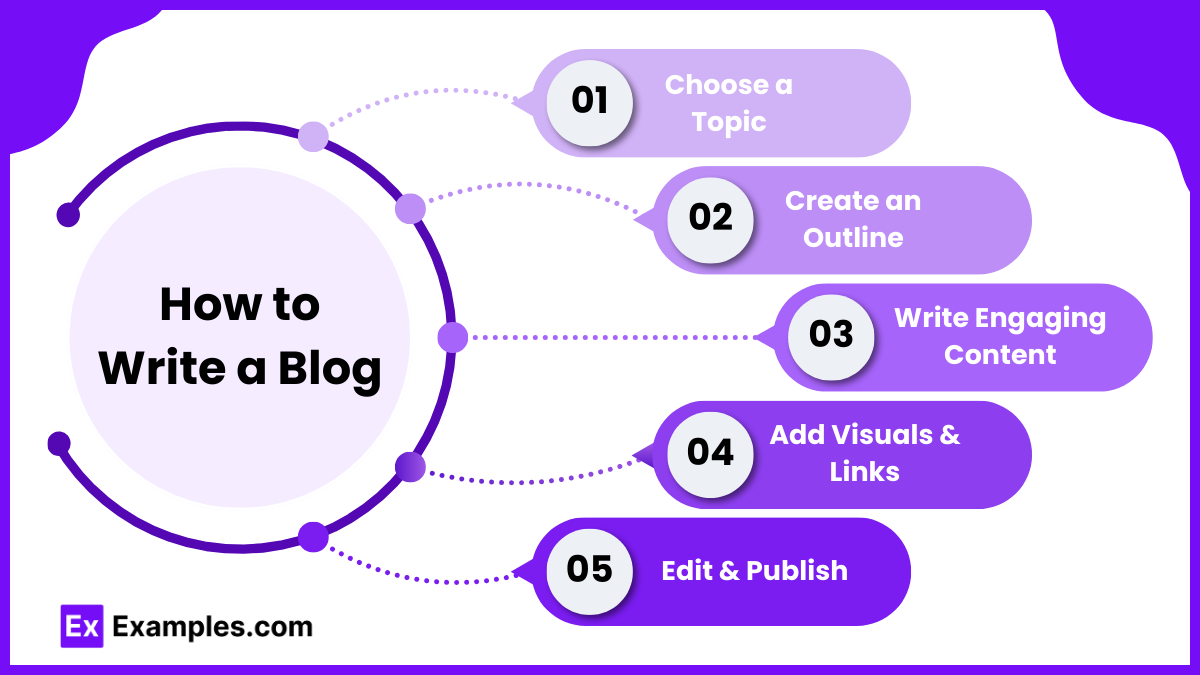
- Choose a Topic – Pick a subject that interests you and your audience.
- Create an Outline – Structure your blog with an introduction, main points, and a conclusion.
- Write Engaging Content – Use clear, concise language with a friendly tone.
- Add Visuals & Links – Include images, videos, and relevant links to enhance readability.
- Edit & Publish – Proofread your content, optimize for SEO, and publish it online.
How to Start a Blog?
Starting a blog involves several steps, from planning your content to launching your site. Here’s a straightforward guide to help you begin:
Define Your Niche
Identify your interests and expertise: Choose a topic you are passionate about and knowledgeable in. This could range from fashion, technology, and travel to personal finance, cooking, or even niche hobbies.
Choose a Blogging Platform
Popular options include:WordPress: Highly customizable, great for those who want control over their site’s design and functionality.
Blogger: A simple, straightforward platform owned by Google.
Squarespace: Offers beautiful design templates and is user-friendly.
Wix: Drag-and-drop website builder, easy to use with a variety of design options.Pick a Domain Name
Reflect your niche: Choose a name that corresponds with your blog’s theme.
Keep it memorable and concise.
Check availability: Ensure the domain name is available and register it through a domain registrar like GoDaddy, Namecheap, or Google Domains.Set Up Your Blog
Install your platform: Most platforms offer guides on setting up and customizing your blog.
Choose a theme or template: Select a design that fits your style and niche.
Customize your site: Adjust colors, fonts, and layout to match your branding.Create Compelling Content
Plan your content: Develop a content calendar to schedule your posts.
Write engaging posts: Focus on quality, providing valuable insights or entertaining content that appeals to your target audience.
Use images and videos: Visuals can enhance your posts and attract more viewers.Promote Your Blog
Social media: Share your content on platforms like Facebook, Twitter, Instagram, and Pinterest.
SEO (Search Engine Optimization): Optimize your content with relevant keywords to rank higher in search results.
Engage with your community: Respond to comments and interact with your readers and other bloggers.Monetize Your Blog
Ads: Use platforms like Google AdSense to display ads on your blog.
Affiliate marketing: Earn commissions by promoting other companies’ products related to your niche.
Sell products or services: Create and sell your own products or offer services like consulting or speaking.Analyze and Improve
Track your progress: Use tools like Google Analytics to understand your audience and how they interact with your blog.
Adjust based on feedback: Be open to feedback and ready to make changes to improve your blog.
Importance of Blog
Blogs serve a variety of important functions, both on a personal and professional level. Here’s a breakdown of the key roles and benefits that blogs provide:
1. Expression and Sharing
- Personal Outlet: For individuals, blogs offer a platform to express thoughts, feelings, and experiences. It’s a space for creativity and personal development.
- Sharing Knowledge and Expertise: Professionals and hobbyists alike use blogs to share their expertise and insights with others interested in their field.
2. Community Building and Engagement
- Connecting with Like-Minded Individuals: Blogs can foster communities of people with shared interests, providing a space for discussion and interaction.
- Feedback and Interaction: Through comments and social media shares, bloggers can engage directly with their readers, receive feedback, and foster relationships.
3. Marketing and Promotion
- Brand Building: Businesses use blogs to build and promote their brand by posting content that reflects their values, expertise, and services.
- SEO (Search Engine Optimization): Regularly updated blogs contribute to higher search engine rankings, helping attract more visitors through organic search.
4. Authority and Credibility
- Establishing Expertise: By providing valuable content in a specific field, bloggers can establish themselves as experts, gaining trust and credibility.
- Influence: Influential bloggers often affect their readers’ opinions and can sway market trends in their niche.
5. Monetization
- Revenue Streams: Blogs can be monetized through advertising, affiliate marketing, sponsored posts, and selling products or services.
- Professional Opportunities: Successful bloggers may receive opportunities for speaking, consulting, or writing gigs.
6. Education and Information
- Resource for Learning: Many blogs serve as educational platforms that offer tutorials, how-to guides, and informational content.
- News and Updates: Niche blogs can provide news and updates more quickly than traditional media, especially in specialized fields.
7. Networking
- Connecting with Peers: Blogging can help individuals connect with peers and industry leaders, opening up opportunities for collaboration and growth.
- Professional Development: Engaging with a community of bloggers can lead to professional growth and learning through the exchange of ideas and practices.
8. Personal Growth and Development
- Skill Improvement: Blogging helps in honing writing, marketing, and technical skills, among others.
- Self-Motivation: Managing a blog requires discipline and initiative, fostering personal growth and self-motivation.
Tips for Blog
Certainly! Here are some streamlined tips for creating and maintaining an effective blog:
- Know your audience well. Tailor your content to address their specific needs, questions, and interests. Regularly engage with them through comments, surveys, or social media to gain insights and foster a community.
- Focus on creating quality content. Ensure your posts are informative, well-researched, and offer practical advice or insights that readers can use. Consistency is key, so aim to update your blog regularly to keep your audience engaged and encourage repeat visits.
- Optimize your blog for search engines to increase visibility. Incorporate relevant keywords naturally throughout your posts, and ensure each post has a clear, concise meta description. Also, structure your posts with clear headings to make them more scannable for both readers and search engines.
- Use compelling visuals and multimedia. Enhance your posts with relevant images, videos, or infographics to break up text, illustrate points, and keep the audience engaged. Visuals are particularly effective on social media, helping to increase shares and traffic to your blog.
- Promote your content effectively. Share your posts on social media, use email newsletters to notify subscribers about new content, and consider collaborating with other bloggers or influencers to reach a wider audience. Effective promotion is essential to grow your blog’s readership.
- Monitor and analyze your blog’s performance. Use tools like Google Analytics to track visitor behavior, which will help you understand what works and what doesn’t. This data can guide your content strategy and help optimize your blogging efforts for better results.
FAQs
What is the purpose of this blog?
This blog aims to provide insightful articles, tips, and discussions on [insert your blog’s main topic, e.g., technology, cooking, travel, etc.]. We strive to help our readers stay informed and engaged with the latest trends and information in the field.
How can I subscribe to the blog updates?
You can subscribe by entering your email address in the subscription form found at the bottom of the homepage. This will ensure you receive all the latest posts and updates directly via email.
Who writes the content for this blog?
Our content is written by a team of experienced [writers, industry experts, enthusiasts, etc.], each specializing in different aspects of [your blog’s topic]. Learn more about our team on the ‘About Us’ page.
How can I support the blog?
You can support us by subscribing, sharing our content with your network, and engaging with our posts by leaving comments and feedback. If you’re interested in sponsoring the blog or advertising with us, please visit our ‘Support Us’ page.
How often is the blog updated?
We update our blog regularly with new posts every [mention the frequency, e.g., week, month]. Subscribe to our newsletter to get updates directly to your inbox!


